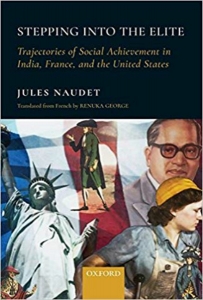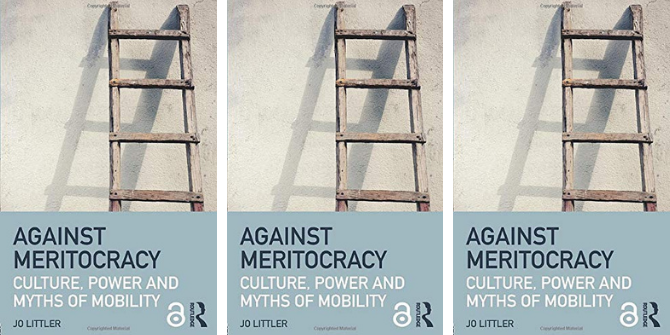In Stepping into the Elite: Trajectories of Social Achievement in India, France and the United States, Jules Naudet draws on interviews with individuals in these three nations to explore the experience of upward mobility as implying an unavoidable tension between the class of origin and the class of destination. Malik Fercovic welcomes the book’s narrative and comparative approach as a valuable contribution to the field that should serve as a benchmark for future scholarly debate.
Stepping into the Elite: Trajectories of Social Achievement in India, France and the United States. Jules Naudet (trans. by Renuka George). Oxford University Press. 2018.
 Find this book (affiliate link):
Find this book (affiliate link): ![]()
Over the past decades, there has been a continual flow of research on social mobility. For most of this time, under the leading influence of British sociologist John Goldthorpe, the study of social mobility has adopted a distinctive quantitative and comparative approach. Focusing on occupation as the key variable to define social class and using representative national surveys, Goldthorpe-inspired work has proved highly effective not only in Britain but internationally as well, tracking intergenerational mobility patterns across the world. In more recent years, however, an alternative approach has challenged Goldthorpe’s dominance. Largely influenced by French sociologist Pierre Bourdieu, this literature has brought to the fore the cultural forms of contemporary class division. Using Bourdieu’s conceptual triad – capitals, habitus and fields – this perspective has addressed social class and mobility as a process rather than a variable. Though frequently lacking a comparative approach, the main focus of this literature concerns the persistence of inequality across generations, with especial attention to the role of cultural capital in this process.
In dialogue with these two streams of scholarship, Jules Naudet’s Stepping into the Elite: Trajectories of Social Achievement in India, France and the United States opens new vistas for the debate on class and mobility. Based on extensive qualitative research, Naudet analyses the experience of upward mobility in three nations with different social stratification patterns: a closed society sustained by a caste system (India); a society still marked by the weight of class and status inherited from the aristocratic Ancien Régime (France); and a supposedly open society based on merit and individual capacity alone (US). Naudet’s focus is on how the available cultural frames in these different nations shape the way upwardly mobile individuals reaching high-status occupations make sense of their dislocated positions in the social space. Naudet’s book thus preserves the comparative perspective associated with Goldthorpe, but also expands our understanding of how culture moulds the experience of social mobility beyond Bourdieu’s key notion of cultural capital. In so doing, Naudet has added an original contribution to the literature addressing the comparative study of social inequality and mobility.
Stepping into the Elite’s theoretical starting point is to consider the experience of upward mobility as implying an unavoidable tension between the class of origin and the class of destination. This tension is shaped by both ‘sociological’ – entailing a double or contradictory socialisation – and ‘moral’ – concerning people’s allegiances and engagements – characteristics. According to Naudet, this twofold tension goes hand-in-hand with the need to reduce the conflict between highly dissimilar social milieus. Exposed by their upward trajectories to the choice between loyalty to the group of origin and the legitimacy of their new social positions, upwardly mobile individuals are confronted with the challenge of building a consistent narrative of their self and place in the social space. It is the narrative of this experience that is at the centre of Naudet’s approach, as well as his hopes to reconcile the opposing findings in the existing literature studying the effects of mobility on individuals.
 Image Credit: Heartland installation. Installation by Karen Casey, Docklands, Melbourne (rubixcom CC BY 2.0)
Image Credit: Heartland installation. Installation by Karen Casey, Docklands, Melbourne (rubixcom CC BY 2.0)
To address this question, in addition to the philosophical writings of Paul Ricoeur on narrative identity, Naudet draws on three complementary perspectives. Naudet’s approach adopts the ‘sociology of critical capacity’ advanced by Luc Boltanski as the best way to acknowledge that upwardly mobile people are competent, if limited, interpreters of themselves and their dislocated position in the social space. Naudet’s comparative approach also builds from Michèlle Lamont’s notion of cultural repertoires (e.g. shared narratives, ideologies or myths) as available resources shaping upwardly mobile people’s identities. Finally, influenced by Clifford Geertz and Maurice Merleau-Ponty, Naudet coins the concept of ‘instituted ideology’ to account for both national and sub-national analytical levels. This term refers to the ‘degree of congruence of ideologies’ within each country’s key institutions, such as the family, schools, universities and work, and how this facilitates or hinders the experience of mobility.
Stepping into the Elite is based on 160 interviews conducted among upwardly mobile people reaching prestigious occupations in the senior civil service, the private sector and academia. Naudet recruited respondents through alumni networks of Higher Education institutions and the diffusion emails among professional associations. To ensure respondents have a steep upward mobility trajectory, Naudet had to target people whose class of origin is characterised by being highly distant from their class of destination. For Naudet, this meant comparatively engaging with key concepts such as class, caste and race, both within and across the societies under study. In India, for instance, the working classes are not equivalent to the lower castes; in the US, racial origins weigh more heavily than class origins; in France, classes populaires are not the same as the working classes in Anglo-Saxon societies. Naudet does acknowledge the limitations of all this for his definition of the class of origin and recommends caution in the interpretation of his findings. Curiously enough, however, Naudet avoids any sustained comparative discussion of the classes of destination, the key notion of ‘the elite’ and how they are understood differently in the three societies under study. This is a highly surprising void, because it is very likely that the specific nature of the elites varies considerably across national contexts.
Still, Stepping into the Elite reveals stimulating empirical findings. In India, social mobility is experienced through the inescapable influence of the caste system. Portrayed as a ‘succeeding without betraying’, the narratives of respondents emphasised a strong social and moral pressure, insisting on the ‘debt’ that upwardly mobile individuals have to their group of origin. This is especially true in the case of the Dalits. Upwardly mobile Dalits not only provide constant financial aid and support institutions for the promotion of people from the same lower caste. They also perceive themselves as the representatives, in the advanced positions of Indian society, of a ‘community in struggle’ – a vision embedded in the political process of vindication of the Dalits led by Ambedkar. All this shapes the experience of mobility as a collective rather than individual undertaking: upwardly mobile Dalits have at their disposal potent cultural resources to make sense of their upward trajectories while keeping a strong solidarity with their community of origin.
In the United States, upward mobility is lived as a ‘unquestioned success’. The narratives of upwardly mobile individuals emphasise a persistent anchoring of the ‘American dream’ across generations. This is based on the taken-for-granted beneficial role of social competition, the belief in the permeability of class boundaries and the reward of asceticism or loyalty to family values as a durable way to stay ‘grounded’ or ‘rooted’. If upwardly mobile Americans have been successful in their career pathways, this does not imply that their sense of identity has become substantially different: they embody the same values that govern, according to them, the culture shaping both the group origin and destination. The distance between the two social environments gives the impression of being reconcilable without major difficulties. Nevertheless, these experiences are not uniform, and African American interviewees, for instance, are more distant from the prevailing narrative. Indeed, among this group, upward social mobility is perceived as more fragile, with a racial stigma negatively influencing their chances of success. According to Naudet, this makes African Americans more sceptical of a vision of society in which the weight of social class still deeply shapes people’s life chances.
In France, on the contrary, access to the elite is experienced as a vigorous discontinuity with the group of origin by upwardly mobile people. Characterised as ‘a mobility haunted by class’, the class of origin and destination are presented in sharply antagonistic terms. Indeed, as their social advancement develops, respondents perceive they have moved to a different social class based on very different cultural and ideological referents. A deep, and often painful, transformation of the self is thus necessary for upwardly mobile individuals, frequently leading to a break with the class of origin. Naudet’s findings confirm the weight of different educational institutions in access to the elite as being particularly pivotal in the French case. Here the relevant contrast lies between the less prestigious opportunities open at universities and the elitist Grandes Écoles, particularly the École Nationale d’Administration and Sciences Po – the latter making greater the gap between the class of origin and destination. And yet there are important differences in the way upward mobility is lived, depending on the interviewees’ connection to the ‘republican ideology’ – combining the principle of equal opportunity with state intervention to diminish inequality – among older generations of civil servants or the specific experience of individuals from the former French colonies.
Stepping into the Elite thus persuasively shows that culture matters in the analysis of the experience of upward mobility. Going beyond an exclusive focus on cultural capital associated with Bourdieusian perspectives, Naudet’s narrative and comparative approach enriches our understanding of how culture moulds the identities of upwardly mobile people. Cultural repertoires are crucial in this respect. Available cultural frames such as national ‘ideologies’ like the American Dream – rooted in the social and political history of each country – play a key part in these repertoires, since they form a strong shared basis from which individuals build a coherent life narrative and one’s distinctive place in the social world. But upwardly mobile people’s identities are also influenced by sub-national repertoires such as those of the Dalits in India, shaping particular socialisations, the specific social milieus they face and the modalities of admission to the elite. Here the concept of ‘instituted ideology’ is helpful and leads us to think differently about the experience of upward mobility depending on the influence of different cultural, political and social institutional contexts on individual trajectories. In showing this, Naudet marshals compelling and emotional interview material – which testifies to his skill in establishing rapport with his respondents – as well as a fairly balanced account of individual experiences and collective frameworks. All this deserves high praise.
And yet even good books leave unanswered some important issues they themselves raise. In methodological terms, conspicuously absent in Stepping into the Elite is a reflection on the strengths and limitations of interviewing. All data-collecting techniques tend to encourage or obstruct certain forms of discourse or interactions. Interviews are no exception. Interviews provide a weaker basis to explain institutional patterns and depend on individual perspectives to account for collective meanings or behaviour as well as bias to create consistency in narratives and worldviews. All these aspects are relevant for Naudet’s perspective, though the latter seems less significant as his main interest is to understand how upwardly mobile individuals make sense of their trajectories in discursive terms. But these methodological considerations are connected to a larger theoretical point as well. At the outset, Naudet claims that his narrative approach is at least partially able to reconcile the opposing findings in the existing literature studying the effects of mobility on individuals. This claim, however, is not necessarily confirmed by his study. Naudet’s approach risks suggesting that available cultural repertoires and upwardly mobile people’s narratives are the main elements that can account for the experience of mobility and the processes of inclusion/exclusion at the upper echelons of society.
Although Stepping into the Elite is in my view somewhat limited by these unacknowledged questions, such reflections do not diminish the challenging and innovative character of this comparative research. Naudet’s book is one of the most interesting contributions to the topic for quite some time, and should serve as a benchmark for future scholarly debate in the years to come.
Note: This review gives the views of the author, and not the position of the LSE Review of Books blog, or of the London School of Economics. The LSE RB blog may receive a small commission if you choose to make a purchase through the above Amazon affiliate link. This is entirely independent of the coverage of the book on LSE Review of Books.








6 Comments